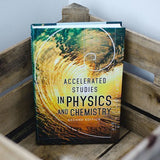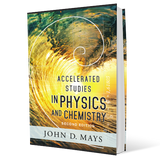- Description
- Specifications
- Contributors
- Support
- Ebook
-
ASPC is an ideal first science course designed for 9th grade accelerated or "honors" students. These are students who love science, are strong in math, and aspire to a technical career or college program. Freshmen who have completed Algebra I (for example, in 8th grade) are typically best suited to this book. The math is Algebra I level, but exercises are intentionally a little more challenging.
ASPC includes a full physics course, similar to Introductory Physics, but completes the physics by late-February to move into chemistry. After completing this text, students will be prepared to go on to Chemistry for Accelerated Students.
ASPC surpasses other physical science texts by providing a unified, in-depth scope, teaching students to use correct terminology, to communicate in succinct technical writing, and drawing infrequently overlooked worldview matters: understanding accurately what a theory is (and what it is not), the cycle of scientific enterprise, the research community and the history of science. What is knowledge? What kind of information does science give us? What does it mean that human beings can observe and understand the world? What does it mean that mathematics is able to model the natural world?
But the crown jewel of all Novare curriculum is the "Mastery-Learning Paradigm" that breaks the "Cram-Pass-Forget Cycle" and replaces it with "Learn, Master, Retain." Mastery-learning is a system designed to dramatically improve long term retention of content. One key strategy for mastery-learning is that all regular assessments (weekly quizzes) are cumulative. Students will develop a system of review so that they rehearse prior concepts as they are learning new ones. The Weekly Review Guides (included with the Digital Resources for Accelerated Studies in Physics and Chemistry, Second Edition) are the key to helping students to develop a better study routine and to manage their personal academic life with diligence.
Novare Science & Math takes special pride in publishing top-quality textbooks. The sturdy hardback texts also have a smyth-sewn binding: the spine will never crack and pages never fall out. Our page layout philosophy aims for a clean, engaging presentation—not loud and gaudy like so many texts that try to imitate popular media, but not minimalistic and boring either.
Textbooks feature a clear objectives list at the beginning of each chapter—the student's best friend, so students know exactly what they are accountable to know. Also, answers to calculation exercises are provided right on the same page because of our belief that students need those answers when they are working the problems. This means that homework is not part of their course grade, another unique method that we advocate. Use homework as a learning opportunity, a time to make mistakes and wrestle through to the right answer, not as an assessment of student learning, and not as a padding for poor test grades.
Finally, in the spirit of "drawing students upward into the adult world of science," the six lab experiments for this book emphasize procedures and skills used in real science labs. Scientific notation, metric prefixes, unit conversions, keeping a lab journal, and the writing of lab reports are essential skills that students will thoroughly learn in this text.
If you need to order the charter school version of this text, please visit this page.
Hardback
ISBN: 9780998983349
Pages: 451
Dimensions: 6.75in x 9.75in
-
John D. Mays, Author

After receiving his BS in Electrical Engineering from Texas A&M University, John D. Mays worked for 14 years as an electrical engineering and engineering manager in the areas of electrical, control, and telecommunications systems. Drawn toward the field of education, John acquired an MEd in Secondary Education from the University of Houston in 1989, and subsequently completed 36 hours of graduate study in Physics at Texas A&M. Shortly after joining the faculty at Regents School of Austin in 1999, John began work on an MLA at St. Edward's University, which he completed in 2003. John served as Math-Science Department Chair at Regents School for nine years and as Director of the Laser Optics Lab for 10 years. He founded Novare Science & Math in 2009 and is the author of numerous science texts and teacher resources. He now works full time as Director of Science Curriculum for Classical Academic Press.
-










